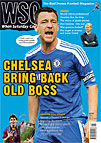 With synthetic surfaces being considered again, Oldham fan Dan Turner looks back at their controversial heyday
With synthetic surfaces being considered again, Oldham fan Dan Turner looks back at their controversial heyday
Sliding tackles were very big in the 1980s everywhere but Boundary Park. Every other week we were treated to the same spectacle. The opposition enforcer would turn up and launch into his “reducer”, no doubt hoping to render one of Oldham’s more creative players lame. Five seconds and half a yard of skin later, the visiting hard man would return gingerly to the perpendicular with a few doubts about his likely effectiveness over the remaining 80-odd minutes. The plastic pitch had claimed another victim.
Between 1986, when the pitch was first laid, and 1991, when it was torn up to comply with new League regulations, there were some cracking injuries. Bloodied elbows and raw, pink friction-burns were ten-a-penny. And then there were Neville Southall’s knees. Twice during Oldham’s epic 1990 FA Cup fifth-round tie with Everton, which went to a second replay (remember them?), Big Nev left the field looking like someone had attacked his kneecaps with a cheese grater.
With this kind of bodily mayhem occurring, there was a predictable cacophony of criticism from opposition managers about playing on our plastic. However, the psychological effect it had on some players was the real story. Before the League Cup semi-final first leg in 1990, West Ham’s Kevin Keen noted that, even if the away team lost the first game 3-0, they felt they could turn the tie around at Upton Park. Such a naked display of fear must have played a part in the result that night, where the six goals the Hammers conceded could easily have been ten.
The Boundary Park pitch had an entertaining relationship with the weather during this period. As anyone who has visited this part of Lancashire will happily confirm, there is a lot of weather about. Rain made the ball zip around in pinball fashion. On occasions like these, opposition wingers who got a little over-excited ended up hurdling as many advertising hoardings as they did tackles – usually with all the grace of an octopus falling off a wall.
On one memorable night against Ipswich in the late 1980s, the groundstaff attempted to neutralise such danger by dumping a ton of sand on the surface. The glare of the floodlights and the composition of this “beach” combined to give the impression that the pitch had been lit from beneath. That night, Boundary Park must have joined the Great Wall of China as the only man-made structure on Earth visible from space. It didn’t impress the Ipswich players much, though, as Oldham strolled to a 4-1 victory.
All of these stories feed the one core argument that raged throughout the five years of Astroturf: Did the Boundary Park surface give the home side an unfair advantage? The answer is not as simple as it sounds. If you restricted your analysis to the club’s two greatest ever seasons – between 1989 and 1991 – you could not avoid the conclusion that it was a giant help: 58 games in league and cups yielded only two defeats.
However, a broader view changes things. For instance, the first three seasons on plastic, beginning in 1986-87, produced inconsistent home records barely any different from the three years immediately preceding them. When the club tore up the plastic for their first season in the top flight in 68 years in 1991-92, the team still achieved a return of 11 wins, five draws and five defeats at home. Given the increase in the quality of the opposition, this was a more than decent effort.
According to the club, to reinstall an artificial pitch today would cost north of £500,000. On purely footballing terms, it would not be worth the expense. When Oldham were a good team, they won a lot at home; when they were bad, they didn’t. Good opponents turned up at Boundary Park and played us off the park. So, occasionally, did bad ones. Cultured, controlled, one-touch teams did not have noticeably more success on plastic than the hit-it-and-hope, long-ball merchants of the day. If you look past some of the more gruesome injuries, it is hard to avoid the impression that it was all just like playing on grass, really.
From WSC 303 May 2012